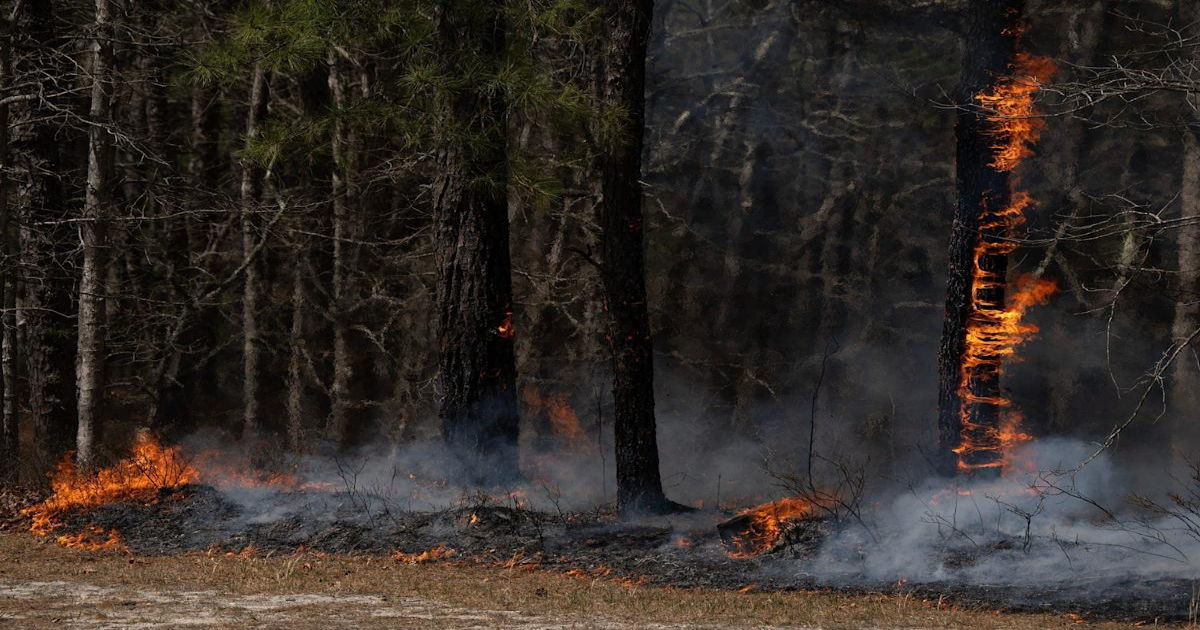As a wildfire burns in Ocean County, New Jersey, prompting evacuations and threatening property, New Yorkers should know their fire risk and how to prevent wildfires in the Empire State.
As of April 23, the fire in New Jersey had burned through 8,500 acres, according to the Asbury Park Press. Thousands of residents have been evacuated since the fire started Tuesday morning, which has also knocked out power to much of the area and forced the closure of a portion of the Garden State Parkway.
While New York’s wildfire season lasts from early spring through October, spring poses a heightened risk (48% of all fire department wildfire responses occur in the period between March 15 and May 16, the New York State Department of Environmental Conservation website says.)
Read on for what to know about wildfire season and how to prevent fires.
Hudson Valley at ‘High’ risk of fire April 23
According to the NYDEC, the Hudson Valley is at “High” risk Wednesday, April 23, for fire.
“All fine dead fuels ignite readily and fires start easily from most causes. Unattended brush and campfires are likely to escape. Fires spread rapidly and short-distance spotting is common,” the DEC site says of the risk. “High-intensity burning may develop on slopes or in concentrations of fine fuels. Fires may become serious and their control difficult unless they are attacked successfully while small.”
Westchester: How FEMA funding cuts could stop dam fixes meant to decrease flood risk
New York burn ban in effect until May 14
A March wildfire that burned through 200 acres of forest in Suffolk County prompted Gov. Kathy Hochul to impose a regional burn ban on areas of downstate New York, which included Long Island, the Hudson Valley and the five boroughs of New York City.
That ban expired March 16, but the annual statewide burn ban started immediately after.
The NYSDEC has been enforcing an annual brush burning ban for New York since 2009. That ban lasts until May 14. It’s purpose is to prevent wildfires and protect New Yorkers during heightened fire risk periods.
“The period in the spring after snow melt and before green-up is generally when the largest fires occur due to cured grass and forest fuels rapidly becoming available to burn during dry periods with low relative humidity,” the DEC website says.
What is prohibited under New York’s burn ban?
The following is prohibited under the statewide burn ban, according to the NYSDEC:
- Burning refuse, trash, tires, and other solid waste (including the burning of such items in a burn barrel or “similar device.”)
- “Burning loose leaves or leaf piles.”
- “Burning pressure or chemically treated wood, painted or stained wood, or composite wood such as plywood and particle board. Firewood that has been heat treated or kiln-dried is allowed to be burned.”
- Burning large piles of brush collected from local residents at designated municipal sites. “The individual landowners in small towns may burn their brush on-site,” the DEC explains. “Downed limbs and branches generated at a transfer site are also allowed to be burned on-site with the same restrictions.”
Is the Lower Hudson Valley seeing drought conditions?
According to the latest data available from the National Drought Mitigation Center, much of the Hudson Valley is experiencing abnormally dry conditions, with areas of Westchester and Rockland County seeing a “moderate drought” (or D1). Such conditions can cause “some damage to crops, pastures;” and can at times call for voluntary water-use restrictions.
That data differs, however, from the current drought conditions published by the DEC. As of April 23, the entire state is listed as “normal.”
Current weather conditions in the Westchester and Rockland areas are mostly sunny, with highs near 75 degrees, the National Weather Service says. In Putnam County, highs could near 72. There is a chance of precipitation for Friday night in the Lower Hudson Valley region.
“Temperatures will be above normal through the end of the week. Locations away from the coast could see highs in the upper 70s, while closer to the coast will likely stay down in the 50s and 60s,” an NWS forecast says. “Dry conditions are expected until Friday night.”
Good News: A fire burned in Yorktown. These residents ran toward danger to help their neighbors
How to track wildfires, red flag warnings and receive emergency alerts
New York’s Department of Environmental Conservation updates a Fire Danger Map daily, which shows the “Fire Danger Rating Area” risk for each region in the state. The Hudson Valley has its own FDRA.
You can also track wildfires and red flag warnings in real time using the lohud.com New York wildfire and smoke map. The map is updated hourly based on input from the The Wildland Fire Interagency Geospatial Service, Canadian Interagency Forest Fire Centre and NOAA Office of Satellite and Product Operations.
To stay up to date on the latest emergencies, you can sign up for alerts from the New York State Emergency Management Office online at alert.ny.gov, and receive public safety alerts via e-mail, phone, cell phone, fax, pager or on the web.
How to report wildfires, brush fires in New York
Call 9-1-1 in case of a fire emergency. You can also call NYS Park Rangers at 1-833-697-7264 to report a forest fire in a state park.
For more information on the prevention of wildfires, go to dec.ny.gov/environmental-protection/public-safety.
Contributing: USA TODAY Network’s Asbury Park Press.
(This story may update.)
This article originally appeared on Rockland/Westchester Journal News: What New Yorkers should know about wildfire season as NJ fires burn
